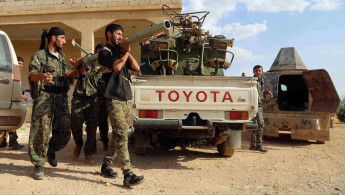US-backed forces enclose IS 'capital' Raqqa after daring airdrop
The US-led coalition this week airdropped troops from the Syrian Democratic Forces behind enemy lines for the first time as part of ongoing operations advancing on the IS held city of Raqqa.
Fighters from the mixed Kurdish and Syrian Arab force - entrusted by the US administration with leading the assault on Raqqa, IS' de facto capital - were dropped on Tuesday near the IS-held town of Taqba aiming to take control of a major dam in the area, the Pentagon said on Wednesday.
The Tabqa dam is located around 40 km west of Raqqa, which is situated on the northeast bank of the Euphrates river, around 160km east of Aleppo.
Both the dam and a major airbase located nearbye were taken by IS in 2014 during the height of the extremist group's expansion across swathes of Syria and neighbouring Iraq.
The Pentagon says that the operations is aimed at opening up a new front in the campaign targeting Raqqa.
Twitter Post
|
"Seizing Tabqa Dam will further isolate Raqqa and deny ISIS the ability to move fighters and supplies to defend dwindling strongholds," US State Department official Brett McGurk added on Twitter.
While US military personnel took part in the operation – which involved Apache helicopters, <arine artillery, and air strikes - a coalition spokesman declined to say whether American troops remained present on the ground near Tabqa.
Colonel Joseph Scrocca did however say that around 75 to 80 percent of those forces dropped behind enemy lines were members of the Syria Arab Coalition - an exclusively Arab sub-division of the majority Kurdish SDF.
Twitter Post
|
Speaking to the Pentagon press corps from Baghdad on Wednesday Scrocca added that the Tabqa operation had been made possible by an intensive set of airstrikes targetting IS militants.
Three hundred airstrikes around Tabqa, and to the west of Raqqa, have been conducted in the last four months, leading to the destruction of over 200 fortifications and more than 50 IS vehicles, the coalition spokesman said.
Activists have also reported that they have lead to civilian deaths.
On Thursday, a SDF statement said that the airdrop operation had lasted five hours, and helped forces battling IS take control of a "large swathe of land" with plans to advance and liberate all villages west of Raqqa.
Twitter Post
|
from three sides and in turn provide a strategic advantage and is a
necessary starting point in operations to liberate the city.
Last week Sipan Hemo, head of the YPG, said that the SDF was preparing to begin a final assault on Raqqa in April.
This has not been confirmed by the Pentagon.
The YPG is the strongest fighting force within the SDF but is viewed as a terrorist organisation by Turkey, analogous to the Kurdistan Workers Party (PKK) that has led an insurgency against Ankara since the 1980s.
Turkey has been angered by the US' entrusting of the majority Kurdish SDF with leading assaults on Raqqa.
This has led Ankara backed rebels to clash with SDF forces in Syria since Turkey launched cross-border operations in August 2016.
SDF forces cut the final main road out of Raqqa earlier this month, and are closing in on the city from the north, east and west.
The only exit out of Raqqa now is over the Euphrates south of the city.





 Follow the Middle East's top stories in English at The New Arab on Google News
Follow the Middle East's top stories in English at The New Arab on Google News


